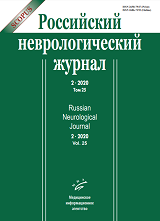
The focus of the journal is to provide neurologists and allied health professionals with up-to-date information on diagnosis and treatment of neurological disorders.
The journal covers relevant topics in practical neurology, including the fields of pediatric and geriatric neurology. Among the topics are neurological complications of systemic diseases, neuropsychiatric borderline states, instrumental and laboratory diagnostic techniques, and organization of neurological care.
The journal publishes original articles, lectures, literature reviews, clinical analyses of diagnostically difficult cases, abstracts of important publications from other journals, and reviews of monographs.
The journal also provides information on upcoming and past congresses, conferences, and symposia held in Russia and the rest of the world.
Current issue
REVIEWS
CLINICAL RESEARCHES AND CASE REPORTS
Announcements
2020-07-03
ОТ ГЛАВНОГО РЕДАКТОРА
Уважаемые коллеги — члены редакционной коллегии, редакционного совета, отечественные и зарубежные авторы и читатели «Российского неврологического журнала».
Рад сообщить вам, что журнал включен в международную базу цитирования Scopus. Напомню, что «Российский неврологический журнал» был создан взамен «Неврологического журнала», издававшегося с 1996 по 2019 г., также цитировавшегося в базе Scopus h-index 3; Q 4.
Планируем в ближайшее время значительно увеличить рейтинг журнала, расширить обхват стран, привлечь большее количество иностранных статей.
Присылайте свои статьи для публикации на сайт журнала https://www.r-n-j.com или по электронной почте rnj@medbook.ru.
Подписывайтесь на журнал:
- печатная версия «Пресса России» — 33358;
- с 2021 г. так же доступна подписка через «Роспечать» — 81575;
- электронная подписка на eLibrary — sales@elibrary.ru.
Главный редактор «Российского неврологического журнала» академик РАН,
заслуженный деятель науки РФ, профессор Н.Н. Яхно
| More Announcements... |






























